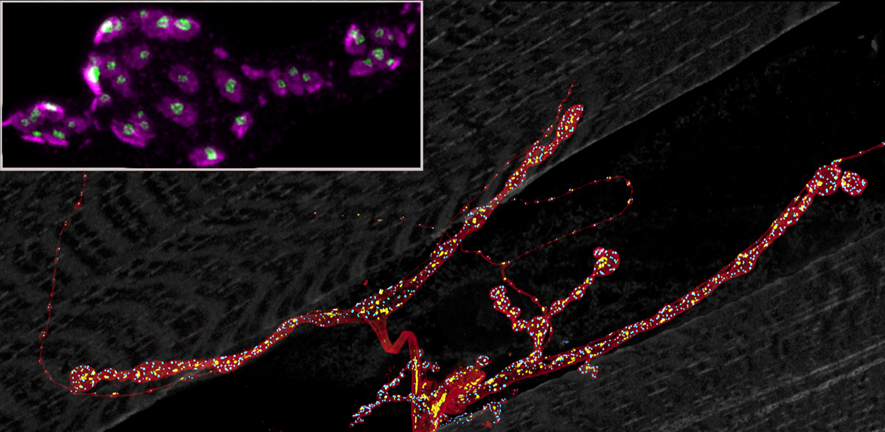
Image: Neuromuscular junction in the Drosophila larva. Motorneuron terminal size (brown), number of synaptic release sites (blue) and of mitochondria (yellow) are all regulated by ROS signals. Inset shows STED super-resolution image of postsynaptic receptor fields (magenta) juxtaposed to presynaptic release sites (green).
Regulation of dendritic and synaptic plasticity by metabolic reactive oxygen species
Supervisor: Prof Matthias Landgraf
Plasticity is fundamental to neuronal development and function. Neurons adjust their excitability, connectivity and structure in response to changes in activity. We discovered that motoneurons monitor their activity by responding to reactive oxygen species (ROS); both metabolic, generated as a by-product of mitochondrial ATP production and, at the plasma membrane, by the ROS producing NAPDH oxidase enzymes. ROS have commonly been thought of as destructive molecules that accumulate with age and degeneration. We identified ROS as important plasticity signals in the nervous system, potentially suggesting energy homeostasis as central to activity-regulated changes.
The molecular mechanisms by which ROS signalling implements synaptic changes now need to be discovered. For example, how is it that presynaptic axon terminals vs. postsynaptic dendrites show different growth responses to changes in activity? We identified the highly conserved, Parkinson’s disease-linked protein DJ-1b as a redox sensor, and PTEN/PI3Kinase as an effector pathway regulating synaptic terminal size. We also find that there is a division of labour, with mitochondrial ROS versus membrane generated ROS mediating distinct cellular adjustments, and Aquaporins channels enabling both autocrine and paracrine signalling via extracellularly generated ROS (by NADPH oxidases).
We are now working to identify the plasticity pathways that are regulated by these distinct sources of ROS.
References
Sobrido-Cameán D, Oswald MCW, Bailey DMD, Mukherjee A, Landgraf M. (2023). Activity-regulated growth of motoneurons at the neuromuscular junction is mediated by NADPH oxidases. Front Cell Neurosci. 16:1106593. doi: 10.3389/fncel.2022.1106593.
Dhawan S, Myers P, Bailey DMD, Ostrovsky AD, Evers JF, Landgraf M. Reactive Oxygen Species Mediate Activity-Regulated Dendritic Plasticity Through NADPH Oxidase and Aquaporin Regulation. Front Cell Neurosci. 2021 Jul 5;15:641802. doi: 10.3389/fncel.2021.641802. PMID: 34290589; PMCID: PMC8288108.
Oswald MCW, Brooks PS, Zwart MF, Mukherjee A, West RJH, Giachello, CNG, Morarach K, Baines RA, Sweeney ST and Landgraf M. (2018). Reactive Oxygen Species Regulate Activity-Dependent Neuronal Structural Plasticity. eLife, 7. http://doi.org/10.7554/eLife.39393
Coulson B, Hunter I, Doran S, Parkin J, Landgraf M, Baines RA. (2022). Critical periods in Drosophila neural network development: Importance to network tuning and therapeutic potential. Front Physiol. 2022 Dec 2;13:1073307. doi: 10.3389/fphys.2022.1073307
